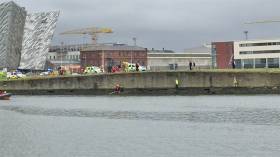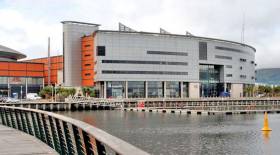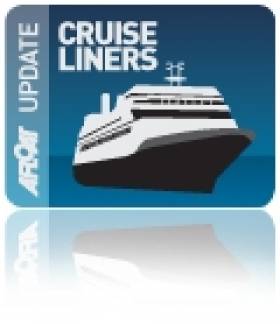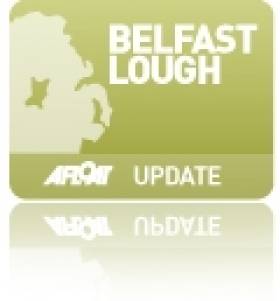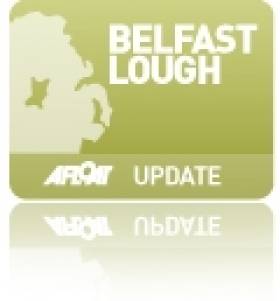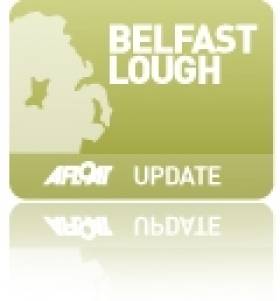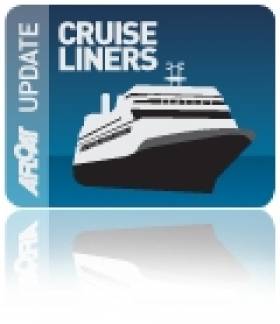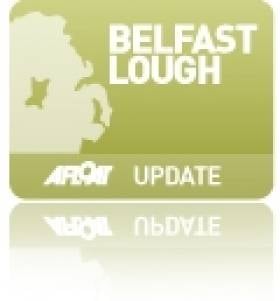Displaying items by tag: Belfast Harbour
#StoneExports - A Belfast Harbour based firm Conexpo that operates stone quarries has won a Dutch order as part of its exports to surface Europe’s busiest roads.
The company won the export order to supply 55,000 tonnes to reconstruct 26km of the road network near Limburg, the southernmost province of the Netherlands. The contract follows a 200,000 tonne order for the newly constructed A15 extension which serves the Port of Rotterdam and which is Europe’s busiest motorway.
Conexpo sources one million tonnes of high quality gritstone annually from its County Down quarries. The stone is processed and exported from its £5m quayside plant located on a seven-hectare site in Belfast Harbour Estate.
Opened in 2015 it’s the only facility in Europe which can simultaneously produce aggregates to UK and European standards. The County Down stone is highly sought after for its ability to improve skid resistance and reduce road noise by up to six decibels.
Jonathan McCluskey, Conexpo’s Managing Director, said: “In partnership with Belfast Harbour we’ve been able to develop a bespoke shipping terminal and processing plant which provides some of the world’s highest quality stone.
“County Down quarry gritstone is increasingly in high demand and has been used in road projects from Hong Kong to Rotterdam, not just for initial construction, but also long-term re-surfacing requirements. Our Belfast Harbour facility has the potential to produce 6,000 tonnes every day, crushing and screening precision-sized stone for the complex honeycomb structures used in modern road surfaces.”
Joe O’Neill, Belfast Harbour’s Commercial Director, added: “Stone exports by Conexpo are one of the most significant commodities handled at Belfast Harbour, representing our fastest growing commodity sector over the last five years.
“Belfast Harbour has worked with Conexpo since it was established 25-years ago, developing facilities to support its ambitious growth plans. Northern Ireland’s quarry sector provides significant economic and employment opportunities and the Harbour will continue to support Conexpo as it continues to develop new export markets.”
Established over 25 years ago, Conexpo employs 45 people directly and supports a further 50 jobs, mainly in the haulage sector. Family owned, the company operates two quarries in County Down and also procures 100,000’s of tonnes of stone from neighbouring County Down quarries.
Woman Rescued After Laganside Fall In Belfast Harbour
#Rescue - A multi-agency response was launched after a woman fell from a quay in Belfast Harbour onto the banks of the River Lagan on Saturday (25 February).
According to the Belfast Telegraph, the woman sustained injuries to her head and limbs after apparently slipping from the quayside onto the rocky riverbank.
Her calls for help were heard across the harbour at the offices of Sunday Life by a reporter, who raised the alarm around noon.
Teams from Lagan Search and Rescue, the NI Fire Service, PSNI and ambulance crews joined the coastguard boat that recovered the woman from the scene in Victoria Channel.
Belfast Policeman Praised For Rescue Of Woman From Water At City Arena
#Rescue - A Belfast Harbour policeman jumped into action on Sunday night (8 January) to rescue a young woman from the waters behind the city’s SSE Arena, as BelfastLive reports.
Police constable and lifeboat volunteer Scott Harkins was part of a team of emergency responders who went to the aid of the woman, in her 20s, who was visiting Belfast with family for an ice hockey game.
Constable Harkins was first on scene and wasted no time in pulling on a lifejacket and leaping into the cold waters of Abercorn Basin to recover the casualty and keep her afloat at the quayside.
BelfastLive has more on the story HERE.
Shipping Review: Waterford Increase Trade, EU Adopt Places of Refuge, Belfast Handles 23m Tonnes
#ShippingReview – Jehan Ashmore reviews the shipping scene over the last fortnight where among the stories are outlined below.
The Port of Waterford reported increases in 2015 across all categories shipped in to and out of the port at Belview.
Uncertainty about China’s economic performance and slowing trade growth will make 2016 a difficult year for shipping executives according to one leading analyst.
European Sea Port Organisation and maritime industry stakeholders co-signed a joint declaration for the recently adopted EU Operational Guidelines on Places of Refuge.
A new director was appointed to UK's top energy port of Milford Haven. Natalie Britton will be tasked among other roles in bringing new business to the Welsh waterway that includes Pembroke ferryport.
Belfast Harbour handled around 23m tonnes in 2015, similar to its throughput for the preceding year.
#CruiseBelfast – Belfast Harbour is to play host to almost 115,000 cruise visitors in 2015, with the first cruiseship Voyager having arrived earlier this morning from Iceland, writes Jehan Ashmore.
The Voyages of Discovery 540 passenger cruiseship opened the season having called to Reykjavik for passengers to witness a total eclipse of the sun. Voyager has 270 cabins in which 87% have ocean views and 35 spacious suites, of those 30 feature balconies.
The 15,396 tonnes ship which is operating 'turnaround' cruises from Portsmouth International Port has recently been awarded the Cruise Critic UK Editors' Picks Award for Best Itineraries. This is where Voyager's call today will offer cruise-goers to visit Northern Ireland's many sights and attractions not just in Belfast but throughout Ulster.
Among the cruise lines calling to the city, are Princess Cruises, Celebrity, All Leisure, Silversea, Majestic, Fred Olsen Cruise Line, Saga Cruises.
A notable caller will be the return of Royal Princess, the biggest ever cruiseship to have visited Beflast port when the Princess Cruises giant last year made her debut call in September.
The giant 141,000 tonnes ship is firstly to call this May and the 3,560 passenger cruiseship is to make several repeat calls scheduled throughout the season. She has 1,780 cabins in which 1,438 with balcony (all outside staterooms feature a balcony).
For further details, visit the Belfast Harbour Cruise caller list, click here.
Belfast Harbour’s New Chairman Sets Out Vision for Port
#NewChairman - Belfast Harbour has a new chairman, David Dobbin, who has been on the port's board from 2012, made his first statement since his appointment last month.
Taking the helm of the harbour's new pilot boat, built by local boat builder Red Bay Boats, Dobbin took the opportunity to set out his vision for the business.
"Belfast Harbour is first and foremost a major port which makes a vital contribution to Northern Ireland's economy handling almost three quarters of all of Northern Ireland's sea borne trade. As the incoming Chairman I am committed to ensuring that Belfast continues to be the most modern and efficient port on the island. With over 23 million tonnes of cargo and 1.4 million ferry and cruise ship passengers passing through the Port annually, it is Northern Ireland's primary gateway to rest of the world.
To read more of his statement, click here.
#GreenAward – The highest scoring level of platinum status has been achieved by Belfast Harbour, in this year's Northern Ireland Environmental Benchmarking Survey.
Now in its sixteenth year, the Survey, generated by Business in the Community's ARENA Network campaign and supported by the Northern Ireland Environment Agency and Charles Hurst Fleet Financial, annually assesses top businesses in Northern Ireland for environmental management, performance and assurance.
104 organisations participated this year and the average overall score decreased from 77% in 2013 to 74% but only 4% of this year's respondents scored less than 40%. The decline in the average score was expected as the Survey underwent an overhaul, demanding tougher calls to provide evidence and a clear focus on corporate strategy.
Environment Minister Mark H Durkan said: "Too many people think creating a better environment means weakening our economy, the challenge of the 21st Century is to invent new ways to deliver excellent environmental performance and create prosperity. The Benchmarking Survey highlights the need for businesses to see the environment as an opportunity and not a barrier. A reduction of environmental impacts through resource efficiency and investment in sustainable technologies, helps to grow their business.
"I praise each organisation who took part in this year's benchmarking Survey. They clearly show how businesses can take effective action within their own companies and champion good environmental stewardship".
The minister added "Through continued partnership between ARENA Network and the Northern Ireland Environment Agency, and with the help of businesses, we can lead the way in challenging and inspiring businesses to go beyond reporting, maintaining and setting targets. We want you to take the reins and go beyond what is required of responsible organisations and to move forward and bring your supply chains with you. Invest, innovate, share and build partnerships."
Belfast Harbour's Safety and Environmental Manager David Knott said: ""This is the 6th year in a row that the Harbour has been awarded a platinum status in the annual Northern Ireland Environmental Benchmarking Survey. Platinum is the highest scoring level and shows how committed the Harbour is to achieving and maintaining high environmental standards. The benchmarking element of the survey allows us to measure how we're performing against other Northern Irish organisations and pushes us to continuously improve our environmental performance.
"I'd like to congratulate all the other finalists who took part in the survey and to thank Business in the Community for their continued support with this. I would also commend participation in this survey to all of those organisations who have not yet taken this opportunity to measure and improve their own environmental performance."
Planning Granted for Belfast Harbour’s City Quays 2
#BelfastCityQuays2 – Following planning permission work is begin on a Belfast Harbour led development that forms part of wider £250m City Quays scheme as previously reported on Afloat.ie.
The work on the site of City Quays 2 an office development of 124,000sq ft is due to begin in Quarter 1, 2015 with completion scheduled for mid-2016.
It is estimated the work to build City Quays 2 will help support 600 direct and indirect construction jobs. The Harbour also revealed that the process of preparing tender documentation for the construction work has already begun.
Welcoming the decision, Graeme Johnston, Belfast Harbour's Property Director, said: "This approval gives Belfast Harbour a springboard to construct another much needed Grade 'A' office development for Belfast. Following Invest NI's recent successes the time is right to further invest in City Quays and support the region's economic development.
"This will complement work taking place on an adjacent waterfront office development, City Quays 1, which has already generated a high degree of interest in the market from both growing indigenous businesses and new market entrants.
"City Quays 2 is a landmark building on Belfast's waterfront; a £20m project that will create 600 much needed direct and indirect construction jobs. Like City Quays 1, it will be developed to high environmental standards with an emphasis on reducing tenants' operating costs. It will also provide open plan, flexible floors deigned to meet the needs of dynamic modern enterprises."
City Quays 2 is part of the wider City Quays scheme, a 20-acre office-led, city-centre development, which will also include residential and retail elements, and a hotel. The scheme was granted outline planning permission in June 2014.
Belfast Harbour has already sought expressions of interest from national and international operators for the hotel, a 300,000 sq. ft., 150 to 200 bedroom waterfront project. The Harbour has confirmed that the calibre and number of responses received from operators has exceeded expectations and that the hotel, with a supporting multi-storey car park, could be open by 2017.
Royal Princess: Belfast Cruise Boom Boosted By Biggest Ever Cruiseship Caller
#RoyalPrincess - Belfast Harbour's booming cruise season reached a highlight today as the largest ever cruiseship to visit the northern port docked, the 141,000 tonnes giant Royal Princess, writes Jehan Ashmore.
The 19 decks of the 3,560 passengers/1,500 crew cruiseship towers above Stormont Wharf where she berthed having sailed from Greenock in Scotland.
She is 330m (1,087ft) long by 44m (217ft) wide and was built by Fincantieri in, Monfalcone, Italy. Last year her she was christened by the Duchess of Cambridge at a ceremony held in Southampton.
The cruiseship has 1,780 cabins in which 1,438 with balcony (all outside staterooms feature a balcony).
Amongst her many luxurious facilities, she features the largest top deck pool ever with a Princess Watercolor Fantasy, an enhanced Movies Under the Stars screen, and a SeaWalk with vertigo inducing views for some, involving a drop of 128 foot looking straight down!
Compared to other fleetmates, she has a larger and expanded atrium with additional entertainment and casual dining options.
The visit of Royal Princess is one of more than 60 cruiseship callers this season in which Cruise Belfast, a marketing partnership between Visit Belfast and Belfast Harbour are promoting the sector which expects a total of 110,000 passengers by the end of October.
Asides todays call of Princess Cruises other large cruiseship operators have made Belfast a port of destination on their itinerary this season attracted by what the city and province has to offer. Leading operators have been Royal Caribbean International, MSC Cruises and Holland America Line.
A sister, Regal Princess entered service in May of this year and a third newbuild, Britannia which will operate for owners Carnival Corporation, through their UK brand P&O Cruises will be launched into service in 2015.
As previously reported, Britannia is to make her debut season with an anchorage call off Dun Laoghaire Harbour next July. She will be the largest ever cruiseship built exclusively to serve the UK market.
NI Minister Greenlights Belfast Harbour Expansion
#BelfastHarbour - 4NI reports that Northern Ireland Environment Minister Mark Durkan has granted planning permission for a 60-acre extension to Belfast Harbour.
The expansion for port-related uses goes hand in hand with last year's announcement of Ireland's first dedicated cruise terminal for Belfast Harbour, that would accommodate next-generation cruise liners carrying more than 4,500 passengers and crew.
Minister Durkan said the expansion plans were "good news for Belfast" in terms of both enhancing the port and providing construction jobs.


























